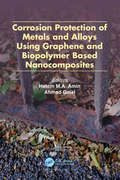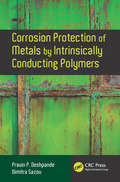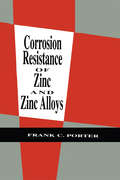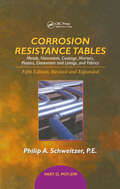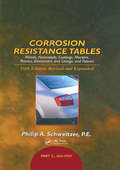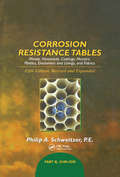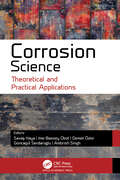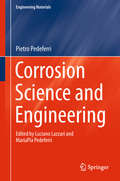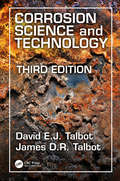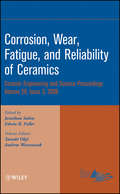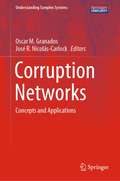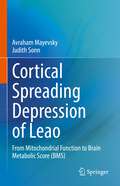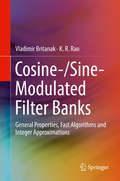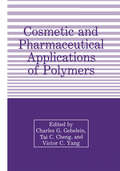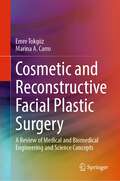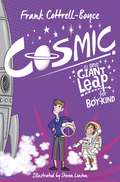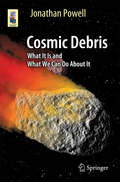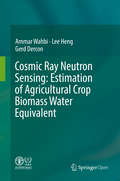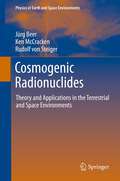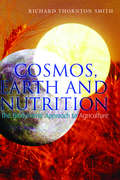- Table View
- List View
Corrosion Protection of Metals and Alloys Using Graphene and Biopolymer Based Nanocomposites
by Hatem M.A. Amin and Ahmed GalalWith contributions from experts from both academia and industry, this book provides up-to-date reviews and promising approaches for corrosion control of metals and alloys via sustainable biopolymers and carbon nanomaterials coatings, focusing on the wonder material “graphene” which is more solid than steel. This book delivers essential information for improving the environmental and economic viability of current coating technologies. It is also a valuable reference for those who are interested in corrosion science and corrosion protection including professionals from the industry as well as academia.
Corrosion Protection of Metals by Intrinsically Conducting Polymers
by Pravin P. DeshpandeThe use of conducting polymers for the anticorrosion protection of metals has attracted great interest during the last 30 years. The design and development of conducting polymers-based coating systems with commercial viability is expected to be advanced by applying nanotechnology and has received substantial attention recently. This book begins wit
Corrosion Resistance of Zinc and Zinc Alloys
by Frank C. PorterA cornerstone reference in the field, this work analyzes available information on the corrosion resistance of zinc and its alloys both as solid materials and as coatings on steel, detailing the corrosion resistance of zinc in atmospheric, aqueous, underground and chemical environments. Corrosion Resistance of Zinc and Zinc Alloys illustrates the nu
Corrosion Resistance Tables: Part D (Corrosion Technology)
by Philip A. Schweitzer, P.E.Devoted to the latest research on mechanisms of corrosion and advancements in corrosion resistance, the updated fifth edition accounts for recent advances and offers a convenient, single-source tabular guide to materials used in the construction of all system components- from vessels to pumps to gaskets and packing- for processes and applications. Part D of 4 parts.
Corrosion Resistance Tables: Part C (Corrosion Technology)
by Philip A. Schweitzer, P.E.Devoted to the latest research on mechanisms of corrosion and advancements in corrosion resistance, the updated fifth edition accounts for recent advances and offers a convenient, single-source tabular guide to materials used in the construction of all system components- from vessels to pumps to gaskets and packing- for processes and applications. Part C of 4 parts, Metals, Nonmetals, Coatings, Mortars, Plastics, Elastomers and Linings, and Fabrics.
Corrosion Resistance Tables: Part B (Corrosion Technology)
by Philip A. Schweitzer, P.E.Devoted to the latest research on mechanisms of corrosion and advancements in corrosion resistance, the updated fifth edition accounts for recent advances and offers a convenient, single-source tabular guide to materials used in the construction of all system components- from vessels to pumps to gaskets and packing- for processes and applications. Part B of 4 parts: Metals, Nonmetals, Coatings, Mortars, Plastics, Elastomers and Linings, and Fabrics.
Corrosion Resistance Tables: Part C (Corrosion Technology)
by Philip A. Schweitzer, P.E.Devoted to the latest research on mechanisms of corrosion and advancements in corrosion resistance, the updated fifth edition accounts for recent advances and offers a convenient, single-source tabular guide to materials used in the construction of all system components- from vessels to pumps to gaskets and packing- for processes and applications. Part C of 4 parts, Metals, Nonmetals, Coatings, Mortars, Plastics, Elastomers and Linings, and Fabrics.
Corrosion Resistance Tables: Part B (Corrosion Technology)
by Philip A. Schweitzer, P.E.Devoted to the latest research on mechanisms of corrosion and advancements in corrosion resistance, the updated fifth edition accounts for recent advances and offers a convenient, single-source tabular guide to materials used in the construction of all system components- from vessels to pumps to gaskets and packing- for processes and applications. Part B of 4 parts: Metals, Nonmetals, Coatings, Mortars, Plastics, Elastomers and Linings, and Fabrics.
Corrosion Resistance Tables: Part D (Corrosion Technology)
by Philip A. Schweitzer, P.E.Devoted to the latest research on mechanisms of corrosion and advancements in corrosion resistance, the updated fifth edition accounts for recent advances and offers a convenient, single-source tabular guide to materials used in the construction of all system components- from vessels to pumps to gaskets and packing- for processes and applications. Part D of 4 parts.
Corrosion Science: Theoretical and Practical Applications (Chapman And Hall/crc Biostatistics Ser.)
by Savaş Ime Bassey Obot Demet Özkır Goncag Ambrish SinghCorrosion studies have attracted considerable interest in the areas of materials chemistry and industrial chemistry, as it affects the direct and indirect costs of industry, leading to huge economic setbacks due to the need for repair, maintenance, and even shutdowns due corrosion damage. This new volume is a comprehensive resource that presents new and up-to-date, theoretical, and experimental corrosion inhibition studies. Corrosion Science: Theoretical and Practical Applications provides an introduction and overview of corrosion science and presents theoretical and experimental studies to mitigate damage from corrosion. Taking an interdisciplinary perspective, this volume is a rich resource of studies and experiments toward solutions that are cost-effective, environmentally friendly, and low in maintenance. The chapters cover an array of topics on the study of corrosion science, exploring different types of materials and various methods of corrosion inhibition. Topics include the use of oil and plant extracts, the application of density functional theory to study anticorrosiove effects, the use of infrared spectroscopy, the introduction of new hybrid sol-gel coatings, an atomistic simulation method, a dynamic electrochemical impedance spectroscopy (DEIS) technique, and much more. This book offers important information on the mechanisms of corrosion science in theory and practice as well as a wealth of corrosion prevention and protection methods.
Corrosion Science: Theoretical and Practical Applications
by Shashi Shekhar Prasad Singh Jatin Agarwal Nag ManiCorrosion studies have attracted considerable interest in the areas of materials chemistry and industrial chemistry, as it affects the direct and indirect costs of industry, leading to huge economic setbacks due to the need for repair, maintenance, and even shutdowns due corrosion damage. This new volume is a comprehensive resource that presents new and up-to-date, theoretical, and experimental corrosion inhibition studies. Corrosion Science: Theoretical and Practical Applications provides an introduction and overview of corrosion science and presents theoretical and experimental studies to mitigate damage from corrosion. Taking an interdisciplinary perspective, this volume is a rich resource of studies and experiments toward solutions that are cost-effective, environmentally friendly, and low in maintenance. The chapters cover an array of topics on the study of corrosion science, exploring different types of materials and various methods of corrosion inhibition. Topics include the use of oil and plant extracts, the application of density functional theory to study anticorrosiove effects, the use of infrared spectroscopy, the introduction of new hybrid sol-gel coatings, an atomistic simulation method, a dynamic electrochemical impedance spectroscopy (DEIS) technique, and much more. This book offers important information on the mechanisms of corrosion science in theory and practice as well as a wealth of corrosion prevention and protection methods.
Corrosion Science and Engineering (Engineering Materials)
by Pietro PedeferriThis textbook discusses the latest advances in the corrosion of metals and related protection methods, and explores all corrosion-related aspects used in natural and industrial environments, including monitoring and testing. Throughout the textbook, the science and engineering of corrosion are merged to help readers perform correct corrosion assessments in both the design phase and plant management phase, and to define the optimal protection technique. In addition, the book addresses basic aspects of corrosion science, including the electrochemical mechanism, thermodynamic and kinetic aspects, the use of Pourbaix and Evans diagrams, and various forms of corrosion (from uniform to localised to stress corrosion phenomena); as well as the protection systems adopted to combat corrosion, including inhibitors, coatings and cathodic protection. Such basic knowledge is fundamental to understanding the “corrosion engineering” approach applied to the durability of metals immersed in water, buried in soil, exposed to the atmosphere, used in reinforced concrete, in the human body and in petrochemical plants, or at risk of high-temperature corrosion. A final chapter is dedicated to the use of statistics in corrosion. All chapters include exercises and practical examples to help students understand, predict, evaluate and mitigate corrosion problems. As such, the book offers the ideal learning resource for all students of corrosion courses in chemical, mechanical, energy and materials engineering at the graduate and advanced undergraduate level, as well as a valuable reference guide for engineers whose work involves real-world applications.
Corrosion Science and Technology
by David E.J. Talbot James D.R. TalbotTwenty years after its first publication, Corrosion Science and Technology continues to be a relevant practical guide for students and professionals interested in material science. This Third Edition thoroughly covers the basic principles of corrosion science in the same reader-friendly manner that made the previous edition invaluable, and enlarges the scope of the content with expanded chapters on processes for various metals and new technologies for limiting costs and metal degradation in a variety of commercial enterprises not explored in previous editions. This book also presents expertly developed methods of corrosion testing and prediction.
Corrosion Science and Technology
by David E.J. Talbot James D.R. TalbotTwenty years after its first publication, Corrosion Science and Technology continues to be a relevant practical guide for students and professionals interested in material science. This Third Edition thoroughly covers the basic principles of corrosion science in the same reader-friendly manner that made the previous edition invaluable, and enlarges the scope of the content with expanded chapters on processes for various metals and new technologies for limiting costs and metal degradation in a variety of commercial enterprises not explored in previous editions. This book also presents expertly developed methods of corrosion testing and prediction.
Corrosion, Wear, Fatigue, and Reliability of Ceramics (Ceramic Engineering and Science Proceedings #347)
by Tatsuki Ohji Andrew WereszczakThis volume provides a one-stop resource, compiling current research on the behavior and reliability of ceramic macro and micro scale systems. It is a collection of papers from The American Ceramic Society s 32nd International Conference on Advanced Ceramics and Composites, January 27-February 1, 2008. Topics include Design and Testing Challenges for Ceramic Joints; Structural Design, Testing and Life Prediction of Monolithic and Composite Components; Mechanical Behavior, Design, and Reliability of Small Scale Systems; Environmental Effects on Mechanical Properties; and more. This is a valuable reference for researchers in ceramics engineering.
Corruption Networks: Concepts and Applications (Understanding Complex Systems)
by Oscar M. Granados José R. Nicolás-CarlockThis book aims to gather the insight of leading experts on corruption and anti-corruption studies working at the scientific frontier of this phenomenon using the multidisciplinary tools of data and network science, in order to present current theoretical, empirical, and operational efforts being performed in order to curb this problem. The research results strengthen the importance of evidence-based approaches in the fight against corruption in all its forms, and foster the discussion about the best ways to convert the obtained knowledge into public policy.The contributed chapters provide comprehensive and multidisciplinary approaches to handle the non-trivial structural and dynamical aspects that characterize the modern social, economic, political and technological systems where corruption takes place.This book will serve a broad multi-disciplinary audience from natural to social scientists, applied mathematicians, including law and policymakers.
Cortical Spreading Depression of Leao: From Mitochondrial Function to Brain Metabolic Score (BMS)
by Avraham Mayevsky Judith SonnThis book focuses on energy metabolism and brain functions related to Cortical Spreading Depression of Leao (CSD), an important issue in brain pathophysiology. The first part of the book offers a comprehensive overview of the history and early research on CSD, and then discusses the recent advances in the technology used to map and monitor brain mitochondrial NADH redox state and other physiological functions during CSD. The chapters explore the connection between CSD and mitochondrial function under hypoxia, Ischemia and various drugs treatment, and provide a resource to scientists researching the development of CSD during various brain pathophysiological conditions. This book is essential to scientists and students working in the field of bioenergetics of the brain and various organs and tissues in the body. The use of this technology is also crucial and applicable in the neuroscience field.
Cosine-/Sine-Modulated Filter Banks: General Properties, Fast Algorithms and Integer Approximations
by K. R. Rao Vladimir BritanakThis book covers various algorithmic developments in the perfect reconstruction cosine/sine-modulated filter banks (TDAC-MDCT/MDST or MLT, MCLT, low delay MDCT, complex exponential/cosine/sine-modulated QMF filter banks), and near-perfect reconstruction QMF banks (pseudo-QMF banks) in detail, including their general mathematical properties, matrix representations, fast algorithms and various methods to integer approximations being recently a new transform technology for lossless audio coding. Each chapter will contain a number of examples and will conclude with problems and exercises. The book reflects the research efforts/activities and achieved results of the authors in the time period over the last 20 years.
Cosmetic and Pharmaceutical Applications of Polymers
by Victor C. Yang Tai C. Cheng Charles G. GebeleinPolymers continue to show almost amazing versatility. We have always known that polymers could be used for trinkets, toys and dishes. Now, however, we are no longer surprised to encounter these adaptable mate rials in almost every place we look. We find them in our cars, tools, electronic devices, building materials, etc. The use of polymeric mate rials in medicine is also well documented in previous books by one of the Editors (Gebelein) and by others. Likewise, the use of polymeric mate rials in pharmaceutical applications, especially in controlled release systems, is also well established. Nevertheless, the use of these ubiquitous chemicals is far less ob vious in the field of cosmetics, although modern cosmetic preparations rely heavily on polymers and this trend is certain to increase. This book brings together much of the basic information on polymers in cosmetics and compares this usage with similar applications in pharmaceutical and medical applications. Cosmetics, like medicine and pharmacy, dates back to antiquity. We can find uses of perfumes, balms and ointments in various old books, such as the Bible. For example, the use of ointments and balms is noted more than thirty eight times, and perfumes and related materials are cited at least twenty nine times in the Bible.
Cosmetic and Reconstructive Facial Plastic Surgery: A Review of Medical and Biomedical Engineering and Science Concepts
by Emre Tokgöz Marina A. CarroCosmetic and Reconstructive Facial Plastic Surgery: Medical and Biomedical Engineering and Science Concepts provides an extensive overview of the most recent technological advancements in facial plastic and reconstructive surgeries and head and neck surgery through a thorough review of the literature in biomedical engineering, technology, and medicine. Coverage includes the most recent engineering and computing techniques, such as robotics, biomechanics, artificial intelligence (AI), deep learning (DL), machine learning (ML), and optimization, as well as the medical and surgical aspects of medical and scientific methods, surgical and non-surgical procedure types, complications, patient care, and psychological factors. This book will be a valuable introduction to concepts and advances for otorhinolaryngology, biomedical researchers, academics, and students.
Cosmic
by Frank Cottrell BoyceIt's one giant leap for all boy-kind in Frank Cottrell Boyce's out-of-this-world story: Cosmic.Liam is too big for his boots. And his football strip. And his school blazer. But being super-sized height-wise has its advantages: he's the only eleven-year-old to ever ride the G-force-defying Cosmic rollercoaster – or to be offered the chance to drive a Porsche. Long-legged Liam makes a giant leap for boy-kind by competing with a group of adults for the chance to go into space. Is Liam the best boy for the job? Sometimes being big isn't all about being a grown-up.This edition of Cosmic includes bonus material and discussion questions from Frank Cottrell Boyce and features fantastic new cover artwork from Steven Lenton.
Cosmic Debris: What It Is and What We Can Do About It (Astronomers' Universe)
by Jonathan PowellThis book examines the mysterious and the well-studied debris in Earth’s crowded neighborhood. From orbiting comets to the workings of the Asteroid Belt, and from meteor showers to our home-grown network of orbiting satellites, the full diversity of space objects and the debris they create is explored. Powell also discusses some of the current research techniques used to find potentially harmful rogue elements, with an emphasis on keeping watch for any objects that may intersect Earth’s orbit. Such bodies also impact other worlds, and much has been learned from observing these encounters.The information in this book is intended to foster thought about the universe in which we live, but without overloading its readers with numbers and lecture-room analysis. Like a good thriller, it allows its readers to pace themselves with the story and, by the end, encourages them to draw their own conclusions.
Cosmic Ray Neutron Sensing: Estimation of Agricultural Crop Biomass Water Equivalent
by Ammar Wahbi Lee Heng Gerd DerconThis open access book provides methods for the estimation of Biomass Water Equivalent (BEW), an essential step for improving the accuracy of area-wide soil moisture by cosmic-ray neutron sensors (CRNS). Three techniques are explained in detail: (i) traditional in-situ destructive sampling, (ii) satellite based remote sensing of plant surfaces, and (iii) biomass estimation via the use of the CRNS itself. The advantages and disadvantages of each method are discussed along with step by step instructions on proper procedures and implementation.
Cosmogenic Radionuclides: Theory and Applications in the Terrestrial and Space Environments (Physics of Earth and Space Environments)
by Jürg Beer Ken McCracken Rudolf SteigerCosmogenic radionuclides are radioactive isotopes which are produced by natural processes and distributed within the Earth system. With a holistic view of the environment the authors show in this book how cosmogenic radionuclides can be used to trace and to reconstruct the history of a large variety of processes. They discuss the way in which cosmogenic radionuclides can assist in the quantification of complex processes in the present-day environment. The book aims to demonstrate to the reader the strength of analytic tools based on cosmogenic radionuclides, their contribution to almost any field of modern science, and how these tools may assist in the solution of many present and future problems that we face here on Earth. The book provides a comprehensive discussion of the basic principles behind the applications of cosmogenic (and other) radionuclides as environmental tracers and dating tools. The second section of the book discusses in some detail the production of radionuclides by cosmic radiation, their transport and distribution in the atmosphere and the hydrosphere, their storage in natural archives, and how they are measured. The third section of the book presents a number of examples selected to illustrate typical tracer and dating applications in a number of different spheres (atmosphere, hydrosphere, geosphere, biosphere, solar physics and astronomy). At the same time the authors have outlined the limitations of the use of cosmogenic radionuclides. Written on a level understandable by graduate students without specialist skills in physics or mathematics, the book addresses a wide audience, ranging from archaeology, biophysics, and geophysics, to atmospheric physics, hydrology, astrophysics and space science.
Cosmos, Earth and Nutrition: The Biodynamic Approach to Agriculture
by Richard Thornton SmithIn recent years there has been an explosion of interest in organic and biodynamic produce. Although once marginal and 'alternative', escalating concerns about the environment, health, food quality and animal welfare have brought organics into mainstream consciousness. Biodynamics, a unique development of the organic approach, does not narrowly focus on agricultural techniques. It was conceived as a new way of thinking about farming, nutrition and the world of nature, allowing for a revitalized relationship with the living soil, the elemental world and the cosmos. Originating from a series of eight lectures given by Dr Rudolf Steiner in 1924, biodynamics broadens the outlook of agriculture and the science behind it, leading to a holistic perspective that incorporates astronomical rhythms and unique preparations for plants and earth. The author describes the foundations on which not only biodynamics but also the wider organic movement is based. He builds bridges between mainstream science and Steiner's insights, making it easier for the wider organic and ecological movement to approach biodynamic concepts and practise. This book has much to offer to the beginner as well as to those already involved with biodynamics. Its broad range of topics - including the ecology of the farm organism, food quality and nutrition, community supported agriculture, planetary influences, seed quality, and the vitality of water - contribute to a deeper understanding of the subject. The author is also concerned to promote innovation so that biodynamics moves with the times. An appendix includes details for contacting various elements of the biodynamic world. DR RICHARD THORNTON SMITH was formerly a geography professor at the University of Leeds, specializing in soil science, environment and conservation. Widely travelled, he has a long-standing interest in indigenous and sustainable farming. He was introduced to the work of Rudolf Steiner at an early age, although his full involvement with biodynamics dates from 1990 when he began to participate in training programmes and workshops at Emerson College, Sussex. In 1996 he began a biodynamic extension programme in Sri Lanka, for which he published a book, most recently updated in 2007. Since 2001 he has been an inspector for the Biodynamic Association's Demeter and Organic Certification in the UK. In 2003 he produced an edited selection of Steiner's work relating to agriculture. He is currently a council member of the Biodynamic Agricultural Association, and lives in Ross-on-Wye, Herefordshire.
